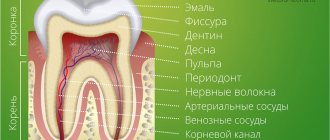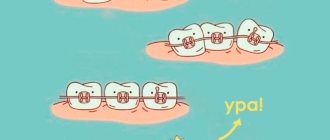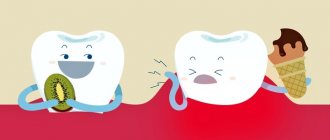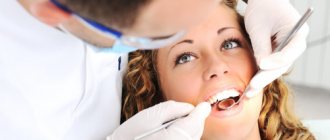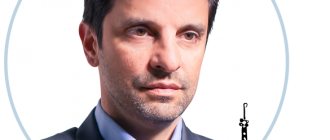Content:
- Why is the position of teeth in a row disturbed?
- Can a crooked tooth fall back into place?
- Consequences of crooked teeth in children
- When should you go to the dentist?
- Devices for correcting uneven teeth
- Prevention Tips
Uneven teeth in children are not only an aesthetic defect. Unfortunately, dental problems can have serious consequences. These include: eating disorders due to improperly chewed food, dysarthria, caries. Due to the uneven arrangement of units in the dentition, plaque accumulates on the enamel due to insufficient hygiene. This leads to the proliferation of pathogenic bacteria, which provokes the formation of caries. That is why you should be careful about your teeth from an early age. My child has uneven teeth, what should I do? It is necessary to visit the pediatric dentist at least twice a year for a preventive examination. Recommended age: children over three years old.
Do adults need to have their baby teeth removed?
Undoubtedly, baby teeth can often cause problems in adults. Firstly, their service life is short, which is why their resistance to caries is much lower compared to permanent ones. Secondly, teeth that do not fall out on time can interfere with the growth of permanent teeth and also cause them to be incorrectly positioned. But this does not mean that if a baby tooth is found in an adult, it must be removed. Everything is individual and depends on the specific situation. Very often, it is recommended to leave baby teeth in adults that are well preserved so that they last as long as they can. After all, sometimes it happens that permanent teeth may never appear in their place.
In any case, what to do with a baby tooth in adults needs to be decided after an X-ray examination is carried out, which will help determine the presence or absence of the rudiments of an unerupted permanent tooth, as well as whether the process of resorption of the baby tooth root is ongoing. If the rudiments are not found and the roots of a baby tooth have not been reabsorbed, and it looks aesthetically pleasing and immobile, then such a baby tooth should not be removed. The same applies to cases where it is X-ray proven that the position of the permanent tooth is such that even after removing the milk tooth, it will not be able to erupt. However, in this case it is better to consult an orthodontist.
Why is the position of teeth in a row disturbed?
Why do teeth grow unevenly? There are several reasons, the main ones are listed below.
- Hereditary predisposition. If parents or other close relatives first developed dental problems in childhood, the risk of acquiring an uneven row of teeth increases significantly.
- Deficiency of calcium, phosphorus and other nutrients in the body. The cause may be both nutritional deficiency and digestive tract disorders.
- Pathology that arose in the antenatal period. Due to excess or lack of amniotic fluid, entanglement with the umbilical cord, and the influence of teratogenic drugs, birth defects appear.
- Diseases of the upper respiratory tract, leading to changes in the function of external respiration.
Factors such as irrational and unhealthy diet, pathology of jaw and dental growth also influence. All this leads to the child’s teeth growing unevenly.
Types of edentia
Missing teeth and deficient bone volume are often associated with advanced age or traumatic injury. But practice shows that there are several types of such violations.
Primary adentia
A rare pathology associated with improper development of the jaws in a baby. It is detected at the time of eruption of milk teeth or when they are replaced by permanent ones. When there are no rudiments of future teeth in the jaw, the anomaly is called true. In case of developmental delay, late appearance of units (often the crowns overlap each other, merging into a single mass) – false. According to statistics, a birth defect is the frequent absence of crowns from the second to the third chewing molar.
Secondary adentia
This type is acquired, a consequence of severe forms of periodontal tissue diseases, injuries, and somatic ailments. Indeed, a common occurrence in older people. One of the accompanying factors in the development of adentia in this category is the lack of effective and gentle methods of dental care and prosthetics in past decades. The most common types are partial edentia (several units missing) and complete edentia (no teeth at all).
Can a crooked tooth fall back into place?
The main question is: does the structure of teeth change over time? Can crooked teeth in childhood cause malocclusion in the future? It is impossible to answer the questions posed unequivocally. The fact is that under the influence of the above reasons for the formation of uneven teeth, the structure of the molars changes. A wide gap forms between the teeth or they grow close to each other. A child has uneven teeth: what to do? First of all, don't panic. In childhood, active growth of the dental apparatus is observed. It is in the period up to 18 years that they are most sensitive to the treatment. At the first suspicion of the formation of uneven teeth, you should immediately seek advice from a pediatric dentist.
Milk teeth and their features
Temporary and permanent teeth have certain differences in structure. The shape of baby teeth is the same as in molars (permanent), but their size is much smaller, the roots are shorter, and the number is different - there are only 20 of them versus 32 permanent teeth (including wisdom teeth). “Children’s” teeth are characterized by a short service life: their roots dissolve over time (as dentists say, “resorb”) approximately 2-3 years after they are fully formed. This process begins with the area touched by the crowns of the permanent teeth growing underneath them.
But it happens that for one reason or another the formation of the rudiments of permanent teeth does not occur. In this case, the roots of baby teeth are more often resorbed as a result of the influence of the rudiments of permanent adjacent teeth. But it happens that this does not happen and “children’s” teeth can then remain in adults - dentists call them persistent (translated from Latin persistere - to remain, to remain).
Consequences of crooked teeth in children
Due to the fact that a child's teeth grow unevenly, many problems may arise in the future. The fact is that the speech apparatus is formed quite early. From the first months, the child learns to speak correctly, pronounce individual letters and even words. If a baby has dental problems, they will immediately manifest themselves from the first years. The first and most common complaint is the smile. The child will be embarrassed about his smile due to the incorrect position of his teeth. In addition, due to dense dentition, the quality of hygiene procedures decreases. In some cases, additional flossing may be necessary each time you eat. If a child's front teeth grow unevenly, they may even experience headaches. Pain in the neck area is also a common occurrence. This pathology occurs due to excessive tension in the temporomandibular apparatus.
Teeth changing mechanism
A child’s nature dictates a sequence of teething. They appear one after another in exact sequence. The central incisors are shown first, and then the lateral incisors, etc. They also fall out at a certain time. The replacement of baby teeth occurs at the age of 6 - 7 years, but there are also deviations. Undesirable factors can interfere with teething. It also happens that all deadlines are violated, in this case it is advisable to go to the dentist. If teething starts too early or late, then there is nothing wrong with it, don’t worry - it won’t affect the baby’s health.
When should you go to the dentist?
What to do if a tooth grows unevenly? The only correct answer is to seek help from specialists at a dental clinic where children's doctors are seen. You should be examined at least twice annually to monitor the dynamics of the process. You should go to the dentist if your child has unevenly set teeth. After the conversation and diagnostic measures, the dentist will be able to give an accurate answer. Treatment may require special devices that should be worn for a long time. Mouthguards, braces, trainers and other devices for changing malocclusion will help cope with the problem.
What is dangerous about malocclusion?
Violations of occlusion entail diverse consequences from gastrointestinal disorders to psychological complexes. If you are already thinking about correcting your bite, you are most likely familiar with its consequences firsthand. It is also worth noting that malocclusion often provokes premature tooth decay, as it is often the cause of pathological abrasion of teeth, the development of caries and periodontitis. In addition, the pathology can lead to overload of the temporomandibular joint, when the patient replaces clicks and crunches when opening and closing the mouth.
Devices for correcting uneven teeth
There are several reliable and effective treatment methods. They differ from each other in some respects. To choose the best option, you should talk to a pediatric dentist who treats children’s teeth. Trainers and removable plates.
They can be used from an early age. Recommended age is 4-6 years. In this case, it is necessary to wear trainers every day; they are often worn at night. The significant difference is that the device is removable.
Aligner trays.
They begin to wear them at the age of 16.
You need to wear them constantly and take them off only when eating. Braces.
They are given mainly to persons over 18 years of age. They need to be worn for a long time, on average about two years.
If the very first teeth are crooked
The first lower incisors erupt between the ages of six months and one year. They often grow in an "L" shape. This is the norm. This situation definitely does not require any treatment. By the time of complete eruption, the units are aligned and become correct.
If parents are very worried, they can speed up the process of stabilizing the position of the incisors. To do this, the baby should be given to drink from a bottle with a special tight nipple with a small hole. When using it, the baby will make more effort when sucking.
Another situation that should not worry is the even spacing between the first teeth. They disappear when the chewing units erupt. Dentists recommend paying attention only to uneven and too wide diastemas. They most often have to be closed with plates and braces.
Prevention Tips
How to prevent the formation of an uneven bite? There are some tips:
- provide the child with proper and balanced nutrition according to his age from the first years of life;
- closely monitor the child’s health;
- prevent the formation of incorrect habits, such as constant chewing on one side or sucking fingers;
- Carry out thorough oral hygiene every day.
It should also be noted that once a child reaches 1 year of age, he should be weaned off pacifiers. The fact is that mechanical action changes the structure of a child’s front teeth. The pacifier can be replaced with special vestibular plates that repeat the anatomical features of the structure of the child’s teeth.
Incorrect growth of wisdom teeth
70% of people who turn to the clinic for help with the eruption of a wisdom tooth are diagnosed with its incorrect location. Often the concept implies a horizontal tilt, excessive grinding into the seven, or the growth of the eighth tooth into the root part of the neighboring one.
- The growth of a tooth under the gum harms the rest. The sooner a person shows interest and finds out exactly how even an unerupted wisdom tooth is located in the jaw, the easier it will be to eliminate the problem when it is discovered. It happens that the figure eight harms the healthy seventh tooth, while still hidden under the gum. While growing, the third molar seems to be trying to push out the neighboring one or rests against its walls, causing damage. It is better to remove such a wisdom tooth in advance, otherwise the risk of damage to a healthy molar increases. Later, you will have to get rid of both the third and second molars, which have lost functionality.
- A similar situation develops when a wisdom tooth erupts at an angle. As it continues to grow, it will begin to prop up the seven. A particularly alarming picture emerges if there is a lack of space on the jaw. Then the dentition loses its alignment. More often this problem occurs in women.
- The recumbent position of a wisdom tooth is also considered unfavorable , especially when the tooth is turned towards the adjacent seventh tooth. A person sometimes argues that preserving his own, albeit pathologically growing, tooth may be useful in the future, when the time comes to install a crown on the tooth. And the recumbent tooth takes up a lot of space in the row, shifting the others and causing their uneven arrangement.
- The fit of the figure eight to the second molar , even with an anatomically correct location, is also not considered a good sign. Excessive crowding of teeth in the depths of the oral cavity almost always causes the development of caries.
- At first glance, the direction of the wisdom tooth towards the cheek However, this is an imaginary impression. A tooth growing sideways regularly causes microdamage to the vulnerable mucous membrane of the cheek. Often leads to gum inflammation and pericoronitis. The seriousness of the situation is enhanced by the fact that the mucous membrane of the cheeks is not rich in pain receptors, so a person sometimes does not even feel the harm being caused.
- As a result, the cheek is damaged from the inside, and the wounded area becomes a gateway for infection and becomes severely inflamed. Gradually, the cells of the mucosa, under the pressure of what is happening, are transformed and replaced by foreign, denser tissue. This indicates the emergence of neoplasms at the site of permanent injury - benign or carcinogenic.
Dentists recommend removing wisdom teeth that are positioned incorrectly in advance. This information is available to the patient after undergoing an X-ray examination. The picture immediately shows how the figure eight is located inside the gum; it becomes possible to predict the result when it erupts.
Ultrasonic removal of wisdom teeth using a piezotome
You don’t even need to wait for the mentioned process to begin; the modern level of development of dentistry allows the doctor to intervene while the tooth is “sleeping” and perform an operation to extract it in adolescence. In youth, such manipulation is tolerated much easier, and tissue regeneration occurs faster and more completely. And by the time you turn twenty-five, the undesirable scenario of the eruption of a crooked wisdom tooth will be a thing of the past.
Make an appointment with surgeons at Dr. Lopaeva’s clinic
Make an appointment
Or call +7(985)532-21-01
Useful tips
Before removing an incorrectly positioned wisdom tooth, we offer a number of tips that will help you prepare and go through the operation more comfortably:
- Try to make an appointment for tooth extraction in the morning. During the night, the hormone cortisol accumulates in the body, which helps to survive stressful situations. In addition, one should take into account the fact that the inevitable bleeding from the wound at the site of the former tooth will stop by the evening, and the person will be able to sleep peacefully.
- Eat well before surgery. As a result, saliva will be released in smaller volumes, and then you will need to leave your jaws alone and not eat for some time.
- If possible, immediately use a cold object and periodically apply it to your cheek on the way home to prevent swelling from forming. A pack of dry ice from a motorist's first aid kit will do.
- At home, rinse your mouth with clean water or medications recommended by your doctor.
- Take medications in the correct dosage, do not get carried away with self-medication and self-prescription of drugs.
Recommendations for a better rehabilitation period after removal of an impacted wisdom tooth:
- You will need to allow a blood clot to form at the site of the extracted tooth. His presence is mandatory. The clot protects the socket from the penetration of bacteria and prevents complete deformation of the gums. Dry socket is dangerous and provokes inflammation.
- Do not touch the blood clot with your tongue, toothbrush bristles, or cutlery. It is not even recommended to use mouth rinse for 2-3 days after surgery. It is better to take the medicine into your mouth, hold it for a while and spit, avoiding the chance of dislodging the clot.
- To stop bleeding, it is permissible to use sterile cotton wool or gauze swabs. It is allowed to moisten with Chlorhexidine, Miramistin. It is prohibited to use hydrogen peroxide!
- For several days you will have to eat soft food and maintain an acceptable temperature of food and drinks.
- You are supposed to temporarily give up physical activity and training. Baths and saunas, swimming pools, solariums are prohibited.
- You cannot heat the surgical area, as this will cause a dangerous inflammatory process. You can apply ice, but under no circumstances keep it on your cheek all the time. Optimal rhythm: 5 minutes cooling, 5 minutes break. If you don’t have ice at home, bags of frozen vegetables and meat from the freezer will do.
- Maintaining oral hygiene is not prohibited. The main thing is to leave the operated area alone in the first days and not try to thoroughly clean the teeth located near the wound. Disinfection can be carried out with solutions of Chlorhexidine, Furacilin, holding it in the mouth and spitting it out, without rinsing.
Medicine knows of cases when wisdom teeth are prescribed to be preserved. But if it grows, pushing neighbors, lies horizontally or rests on the roots of nearby teeth, there is no need to think twice. Such an eight is considered problematic and is deleted without regret.




